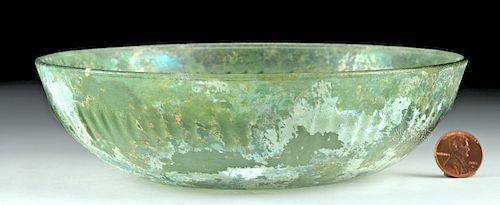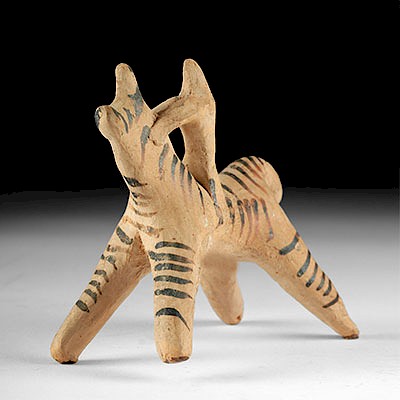Gorgeous Roman Glass Bowl
Lot 53d
About Seller
Artemis Fine Arts
686 S Taylor Ave, Ste 106
Louisville, CO 80027
United States
Selling antiquities, ancient and ethnographic art online since 1993, Artemis Gallery specializes in Classical Antiquities (Egyptian, Greek, Roman, Near Eastern), Asian, Pre-Columbian, African / Tribal / Oceanographic art. Our extensive inventory includes pottery, stone, metal, wood, glass and textil...Read more
Estimate:
$3,000 - $4,500
Absentee vs Live bid
Two ways to bid:
- Leave a max absentee bid and the platform will bid on your behalf up to your maximum bid during the live auction.
- Bid live during the auction and your bids will be submitted real-time to the auctioneer.
Bid Increments
| Price | Bid Increment |
|---|---|
| $0 | $25 |
| $300 | $50 |
| $1,000 | $100 |
| $2,000 | $250 |
| $5,000 | $500 |
| $10,000 | $1,000 |
| $20,000 | $2,500 |
| $50,000 | $5,000 |
| $100,000 | $10,000 |
| $200,000 | $20,000 |
About Auction
By Artemis Fine Arts
Oct 25, 2018
Set Reminder
2018-10-25 11:00:00
2018-10-25 11:00:00
America/New_York
Bidsquare
Bidsquare : Antiquities from Egypt, Greece, Italy, Asia
https://www.bidsquare.com/auctions/artemis-gallery/antiquities-from-egypt-greece-italy-asia-3538
Featuring Egyptian, Greek, Roman, Etruscan, Near Eastern, plus Asian art from Central and Far East. If you love the classics, this is the sale for you. Artemis Fine Arts info@artemisgallery.com
Featuring Egyptian, Greek, Roman, Etruscan, Near Eastern, plus Asian art from Central and Far East. If you love the classics, this is the sale for you. Artemis Fine Arts info@artemisgallery.com
- Lot Description
Roman, early Imperial Period, ca. late 1st century BCE to 1st century CE. A lightly-ribbed bowl made from thick, translucent, pale-green glass. The vessel is mold-made, cast in a shallow phiale-like form, with a slightly concave base and dozens of radiating ribs around the lower body which terminate at the smooth, slightly-rolled rim. This style of glass is known as "pillar-molded," referring to the production technique, where the shape of the bowl was determined by taking a flat sheet of pliable glass and placing it into a solid mold upside-down; this glass was then worked so that it is slipped/sagged over the mold to create the ribs on the exterior. Bowls like this one were used as part of the Roman "cena," or dinner, probably for holding condiments like garum (fermented fish sauce). Size: 6.5" W x 1.875" H (16.5 cm x 4.8 cm).
For a stylistically-similar example in a cobalt-blue hue, please see "Solid Liquid: Greek, Roman, Byzantine and Islamic Glass." Fortuna Fine Arts., Ltd., New York, 1999, p. 41, fig. 48.
Provenance: private East Coast, USA collection
All items legal to buy/sell under U.S. Statute covering cultural patrimony Code 2600, CHAPTER 14, and are guaranteed to be as described or your money back.
A Certificate of Authenticity will accompany all winning bids.
We ship worldwide and handle all shipping in-house for your convenience.
#135644Surface wear and minor abrasions commensurate with age, very minor nicks to rim, and light roughness across exterior surfaces, otherwise intact and near-choice. Light earthen deposits as well as great silver and rainbow iridescence throughout.Condition
- Shipping Info
-
All shipping is handled in-house for your convenience. Your invoice from Artemis Gallery will include shipping calculation instructions. If in doubt, please inquire BEFORE bidding for estimated shipping costs for individual items.
-
- Buyer's Premium



 EUR
EUR CAD
CAD AUD
AUD GBP
GBP MXN
MXN HKD
HKD CNY
CNY MYR
MYR SEK
SEK SGD
SGD CHF
CHF THB
THB















